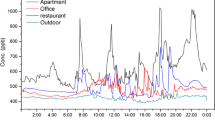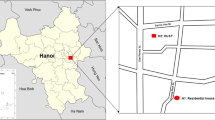Abstract
In this study, we collected particles with aerodynamic diameter ⩽2.5 μm (PM2.5) from three different public indoor places (a supermarket, a commercial office, and a university dining hall) in **an, a medium-sized city located in northern China. Water-soluble inorganic ions of PM2.5 and particle size distributions were also measured. Both indoor and outdoor PM2.5 levels (102.3–143.8 μg·m−3 and 160.2–301.3 μg·m−3, respectively) were substantially higher than the value recommended by the World Health Organization (25 μg·m−3), and outdoor sources were found to be the major contributors to indoor pollutants. Diurnal particle number size distributions were different, while the maximum volume concentrations all appeared to be approximately 300 nm in the three indoor locations. Concentrations of indoor and outdoor PM2.5 were shown to exhibit the same variation trends for the supermarket and dining hall. For the office, PM2.5 concentrations during nighttime were observed to decrease sharply. Among others, SO 2−4 , NH +4 and NO −3 were found to be the dominant water-soluble ions of both indoor and outdoor particles. Concentrations of NO −3 in the supermarket and office during the daytime were observed to decrease sharply, which might be attributed to the fact that the indoor temperature was much higher than the outdoor temperature. In addition, domestic activities such as cleaning, water usage, cooking, and smoking also played roles in degraded indoor air quality. However, the results obtained here might be negatively impacted by the small number of samples and short sampling durations.
Similar content being viewed by others
References
Zhou J, Ito K, Lall R, Lippmann M, Thurston G. Time-series analysis of mortality effects of fine particulate matter components in Detroit and Seattle. Environmental Health Perspectives, 2010, 119 (4): 461–466
Zanobetti A, Schwartz J. The effect of fine and coarse particulate air pollution on mortality: a national analysis. Environmental Health Perspectives, 2009, 117(6): 898–903
Hansen A, Bi P, Nitschke M, Pisaniello D, Ryan P, Sullivan T, Barnett A G. Particulate air pollution and cardiorespiratory hospital admissions in a temperate Australian city: a case-crossover analysis. The Science of the Total Environment, 2012, 416(1): 48–52
Ruuskanen J, Tuch T, Ten Brink H, Peters A, Khlystov A, Mirme A, Kos G P A, Brunekreef B, Wichmann H E, Buzorius G, Vallius M, Kreyling W G, Pekkanen J. Concentrations of ultrafine, fine and PM2.5 particles in three European cities. Atmospheric Environment, 2001, 35(21): 3729–3738
Marcazzan G M, Vaccaro S, Valli G, Vecchi R. Characterisation of PM10 and PM2.5 particulate matter in the ambient air of Milan (Italy). Atmospheric Environment, 2001, 35(27): 4639–4650
Zheng M, Salmon L G, Schauer J J, Zeng L, Kiang C, Zhang Y H, Cass G R. Seasonal trends in PM2.5 source contributions in Bei**g, China. Atmospheric Environment, 2005, 39(22): 3967–3976
Gehrig R, Buchmann B. Characterising seasonal variations and spatial distribution of ambient PM10 and PM2.5 concentrations based on long-term Swiss monitoring data. Atmospheric Environment, 2003, 37(19): 2571–2580
Tian L W, Zhang G Q, Lin Y L, Yu J H, Zhou J, Zhang Q. Mathematical model of particle penetration through smooth/rough building envelop leakages. Building and Environment, 2009, 44(6): 1144–1149
Sundell J. On the history of indoor air quality and health. Indoor Air, 2004, 14(Suppl 7): 51–58
Duan F K, He K B, Ma Y L, Yang FM, Yu X C, Cadle S H, Chan T, Mulawa P A. Concentration and chemical characteristics of PM2.5 in Bei**g, China: 2001–2002. The Science of the Total Environment, 2006, 355(1–3): 264–275
Wang Y, Zhuang G S, Zhang X Y, Huang K, Xu C, Tang A, Chen J M, An Z S. The ion chemistry, seasonal cycle, and sources of PM2.5 and TSP aerosol in Shanghai. Atmospheric Environment, 2006, 40(16): 2935–2952
Wang G H, Wang H, Yu Y J, Gao S X, Feng J F, Gao S T, Wang L S. Chemical characterization of water-soluble components of PM10 and PM2.5 atmospheric aerosols in five locations of Nan**g, China. Atmospheric Environment, 2003, 37(21): 2893–2902
Zhang J, Song H, Tong S, Li L, Liu B, Wan L. Ambient sulfate concentration and chronic disease mortality in Bei**g. The Science of the Total Environment, 2000, 262(1–2): 63–71
Burnett R T, Dales R, Krewski D, Vincent R, Dann T, Brook J R. Associations between ambient particulate sulfate and admissions to Ontario hospitals for cardiac and respiratory diseases. American Journal of Epidemiology, 1995, 142(1): 15–22
Ho K F, Cao J J, Harrison R M, Lee S C, Bau K K. Indoor/outdoor relationships of organic carbon (OC) and elemental carbon (EC) in PM2.5 in roadside environment of Hong Kong. Atmospheric Environment, 2004, 38(37): 6327–6335
Lunden M M, Kirchstetter T M, Thatcher T L, Hering S, Brown N J. Factors affecting the indoor concentrations of carbonaceousaerosols of outdoor origin. Atmospheric Environment, 2008, 42(22): 5660–5671
Pekey B, Bozkurt Z B, Pekey H, Doğan G, Zararsiz A, Efe N, Tuncel G. Indoor/outdoor concentrations and elemental composition of PM10/PM2.5 in urban/industrial areas of Kocaeli City, Turkey. Indoor Air, 2010, 20(2): 112–125
Wang Y G, Hopke P K, Chalupa D C, Utell M J. Long-term characterization of indoor and outdoor ultrafine particles at a commercial building. Environmental Science & Technology, 2010, 44(15): 5775–5780
Smith K R. Indoor air pollution in develo** countries: recommendations for research. Indoor Air, 2002, 12(3): 198–207
Colbeck I, Nasir Z A, Ali Z. The state of indoor air quality in Pakistan—a review. Environmental Science and Pollution Research, 2010, 17(6): 1187–1196
Ohura T, Amagai T, Shen X Y, Li S, Zhang P, Zhu L Z. Comparative study on indoor air quality in Japan and China: Characteristics of residential indoor and outdoor VOCs. Atmospheric Environment, 2009, 43(40): 6352–6359
** X G, Jiang Z G, Li C W. Status and future perspectives of energy consumption and its ecological impacts in the Qinghai-Tibet region. Renewable & Sustainable Energy Reviews, 2011, 15(1): 514–523
Kang S C, Li C L, Wang F Y, Zhang Q G, Cong Z Y. Total suspended particulate matter and toxic elements indoors during cooking with yak dung. Atmospheric Environment, 2009, 43(27): 4243–4246
Yang L X, Wang D C, Cheng S H, Wang Z, Zhou Y, Zhou X H, Wang W X. Influence of meteorological conditions and particulate matter on visual range impairment in **an, China. The Science of the Total Environment, 2007, 383(1–3): 164–173
Cheng S H, Yang L X, Zhou X H, Wang Z, Zhou Y, Gao X M, Nie W, Wang X F, Xu P J, Wang W X. Evaluating PM2.5 ionic components and source apportionment in **an, China from 2004 to 2008 using trajectory statistical methods. Journal of Environmental Monitoring, 2011, 13(6): 1662–1671
Nie W, Wang T, Gao X M, Pathak R K, Wang X F, Gao R, Zhang Q Z, Yang L X, Wang W X. Comparison among filter-based, impactorbased and continuous techniques for measuring atmospheric fine sulfate and nitrate. Atmospheric Environment, 2010, 44(35): 4396–4403
Mouratidou Th, Samara C. PM2.5 and associated ionic component concentrations inside the archaeological museum of Thessaloniki, N. Greece. Atmospheric Environment, 2004, 38(27): 4593–4598
Fromme H, Diemer J, Dietrich S, Cyrys J, Heinrich J, Lang W, Kiranoglu M, Twardella D. Chemical and morphological properties of particulate matter (PM10, PM2.5) in school classrooms and outdoor air. Atmospheric Environment, 2008, 42(27): 6597–6605
Lazaridis M, Aleksandropoulou V, Hanssen J E, Dye C, Eleftheriadis K, Katsivela E. Inorganic and carbonaceous components in indoor/outdoor particulate matter in two residential houses in Oslo, Norway. Journal of the Air & Waste Management Association, 2008, 58(3): 346–356
Wang S X, Wei W, Li D, Aunan K, Hao J M. Air Pollutants in rural homes in Guizhou, China—Concentrations, speciation, and size distribution. Atmospheric Environment, 2010, 44(36): 4575–4581
Liu Y S, Chen R, Shen X X, Mao X L. Wintertime indoor air levels of PM10, PM2.5 and PM1 at public places and their contributions to TSP. Environment International, 2004, 30(2): 189–197
Braniš M, Kolomaznikova J. Monitoring of long-term personal exposure to fine particulate matter (PM2.5). Air Quality Atmosphere & Health, 2010, 3(4): 235–243
Géhin E, Ramalho O, Kirchner S. Size distribution and emission rate measurement of fine and ultrafine particle from indoor human activities. Atmospheric Environment, 2008, 42(35): 8341–8352
Parker J L, Larson R R, Eskelson E, Wood E M, Veranth J M. Particle size distribution and composition in a mechanically ventilated school building during air pollution episodes. Indoor Air, 2008, 18(5): 386–393
Laakso L, Hussein T, Aarnio P, Komppula M, Hiltunen V, Viisanen Y, Kulmala M. Diurnal and annual characteristics of particle mass and number concentrations in urban, rural and Arctic environments in Finland. Atmospheric Environment, 2003, 37(19): 2629–2641
Jones N, Thornton C A, Mark D, Harrison R M. Indoor/outdoor relationships of particulate matter in domestic homes with roadside, urban and rural locations. Atmospheric Environment, 2000, 34(16): 2603–2612
Lunden M M, Revzan K L, Fischer M L, Thatcher T L, Littlejohn D L, Hering S V, Brown N J. The transformation of outdoor ammonium nitrate aerosols in the indoor environment. Atmospheric Environment, 2003, 37(39–40): 5633–5644
Sawant A A, Na K, Zhu X N, Cocker K, Butt S, Song C, Cocker D R III. Characterization of PM2.5 and selected gas-phase compounds at multiple indoor and outdoor sites in Mira Loma, California. Atmospheric Environment, 2004, 38(37): 6269–6278
Bencs L, Ravindra K, de Hoog J, Rasoazanany E O, Deutsch F, Bleux N, Berghmans P, Roekens E, Krata A, Van Grieken R. Mass and ionic composition of atmospheric fine particles over Belgium and their relation with gaseous air pollutants. Journal of Environmental Monitoring, 2008, 10(10): 1148–1157
Zhuang H, Chan C K, Fang M, Wexler A S. Size distributions of particulate sulfate, nitrate, and ammonium at a coastal site in Hong Kong. Atmospheric Environment, 1999, 33(6): 843–853
Loupa G, Kioutsioukis I, Rapsomanikis S. Indoor-outdoor atmospheric particulate matter relationships in naturally ventilated offices. Indoor and Built Environment, 2007, 16(1): 63–69
Na K, Sawant A A, Cocker D R III. Trace elements in fine particulate matter within a community in western Riverside County, CA: focus on residential sites and a local high school. Atmospheric Environment, 2004, 38(18): 2867–2877
Author information
Authors and Affiliations
Corresponding author
Rights and permissions
About this article
Cite this article
Dong, C., Yang, L., Yan, C. et al. Particle size distributions, PM2.5 concentrations and water-soluble inorganic ions in different public indoor environments: a case study in **an, China. Front. Environ. Sci. Eng. 7, 55–65 (2013). https://doi.org/10.1007/s11783-012-0411-1
Received:
Accepted:
Published:
Issue Date:
DOI: https://doi.org/10.1007/s11783-012-0411-1




